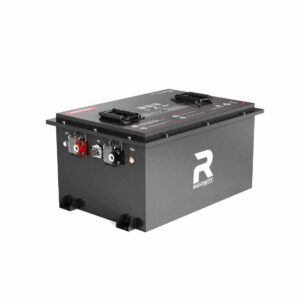What Are the Best RV Battery Types for Seamless Solar Integration?
Lithium-ion, AGM, and lithium iron phosphate (LiFePO4) batteries are the top choices for RV solar integration. Lithium batteries offer higher efficiency, longer lifespan, and faster charging, while AGM provides budget-friendly reliability. LiFePO4 balances safety and performance. These batteries support consistent energy storage, ensuring uninterrupted power for solar-dependent RVs.
How Do Lithium-Ion Batteries Enhance Solar Integration for RVs?
Lithium-ion batteries excel in energy density, allowing compact storage of solar power. They charge 3x faster than lead-acid alternatives and withstand 3,000–5,000 cycles, lasting 10+ years. Their 95% efficiency ensures minimal energy loss during solar charging, making them ideal for off-grid setups requiring rapid, reliable power replenishment.

Advanced lithium-ion chemistry enables dynamic voltage compatibility with solar panels. Unlike AGM batteries that require exact voltage matching, lithium systems automatically adjust to varying solar inputs. This flexibility allows RV owners to expand solar arrays without replacing existing batteries. For example, a 400W solar system can efficiently charge a 200Ah lithium battery bank in 4-5 hours of peak sunlight, versus 8+ hours for AGM equivalents. Built-in cell balancing technology further optimizes energy distribution across battery modules, preventing the “weakest link” degradation common in traditional battery setups.
| Feature | Lithium-Ion | AGM |
|---|---|---|
| Cycle Life | 3,000-5,000 | 500-800 |
| Charge Efficiency | 95% | 80% |
| Weight (100Ah) | 31 lbs | 64 lbs |
Why Are AGM Batteries a Budget-Friendly Solar Option for RVs?
AGM (Absorbent Glass Mat) batteries cost 40% less upfront than lithium-ion, with moderate 500–800 cycle lifespans. They handle deep discharges better than traditional lead-acid, require zero maintenance, and resist vibration. Though heavier and less efficient (80–85%), they’re reliable for short-term solar use in temperate climates.
The sealed construction of AGM batteries makes them ideal for RVs with limited ventilation. Unlike flooded lead-acid batteries, they don’t emit hydrogen gas during charging, allowing safe installation near living spaces. Their lower internal resistance enables decent performance in moderate cold (down to -15°C), though capacity drops significantly below freezing. For weekend campers using 200-300W solar systems, AGM provides sufficient storage at 30-50% the cost of lithium. However, their 50% depth-of-discharge limitation requires larger battery banks compared to lithium alternatives.
What Makes LiFePO4 Batteries Safer for Solar-Powered RVs?
LiFePO4 batteries avoid thermal runaway risks common in standard lithium-ion models. Stable chemistry maintains safe temperatures even during rapid solar charging. They deliver 2,000–7,000 cycles with 100% depth of discharge tolerance, outperforming AGM in longevity. Built-in battery management systems (BMS) prevent overcharging, critical for solar setups with variable input.
How Does Temperature Affect RV Solar Battery Performance?
Lithium batteries operate at -20°C to 60°C (-4°F to 140°F), while AGM fails below -15°C (5°F). Extreme heat accelerates AGM degradation by 50%. LiFePO4 maintains 70% capacity at -20°C, ideal for Arctic RVing. Insulated battery compartments and solar charge controllers with temperature compensation optimize performance in harsh climates.
Which Solar Charge Controllers Maximize Battery Efficiency?
MPPT controllers boost solar harvest by 30% vs. PWM, especially for lithium batteries. They adjust voltage to match battery needs, extracting maximum power. Victron SmartSolar MPPT and Renogy Rover support lithium profiles, enabling seamless communication with BMS. For AGM, PWM suffices but limits solar input to battery voltage.
What Future Tech Could Revolutionize RV Solar Batteries?
Solid-state batteries promise 2x lithium density by 2030, doubling RV solar storage in same space. Graphene-enhanced AGM may bridge cost-efficiency gaps. Solar-integrated batteries with built-in MPPT controllers (e.g., Redway Power’s SunCore) eliminate wiring complexity. AI-driven adaptive charging, like Tesla’s SolarSync, could optimize cycles based on weather forecasts.
“Lithium’s 10-year ROI outperforms AGM despite higher upfront costs. Modern BMS integration allows plug-and-play solar compatibility—Redway’s 300Ah LiFePO4 pairs with 600W solar arrays without external controllers. Future models will embed flexible solar skins, turning battery surfaces into 15% additional harvesters.”
— Redway Power Systems Engineer
Conclusion
For seamless solar integration, lithium variants (LiFePO4 and NMC) lead in efficiency and longevity. AGM suits budget-conscious RVers with stable climates. Prioritize batteries with native solar charge profiles and BMS protection. Emerging tech will further blur lines between storage and generation, but current LiFePO4 remains the gold standard for solar-ready RVs.
The best batteries for RV solar systems today are lithium iron phosphate (LiFePO4) batteries, which offer superior cycle life, lightweight design, and high energy density compared to traditional lead-acid or AGM batteries. LiFePO4 batteries can deliver thousands of charge cycles—often 3,000 to 6,000—making them ideal for long-term off-grid RV use. They also support deeper discharges without damage and recharge more efficiently, maximizing the power harvested from solar panels. Popular options include brands like Renogy, Epoch, and RELiON, which provide smart battery management systems and Bluetooth monitoring for easy status checks. A lifepo4 battery manufacturer such as Fasta Power highlights these batteries’ safety, maintenance-free operation, and compact size, which save space and reduce weight in RVs. Whether you’re dry camping or relying heavily on solar power, choosing the best batteries for RV solar ensures reliable, efficient energy storage and longer battery life, enhancing your off-grid experience.
FAQs
- Can I mix lithium and AGM batteries in my RV solar system?
- No—different voltage curves and charging requirements cause imbalance. Use one battery type per system.
- How often should I replace my RV solar battery?
- LiFePO4: 10–15 years. AGM: 3–5 years. Cycle count depends on depth of discharge—50% DoD doubles cycle life vs 80%.
- Do solar batteries require special maintenance?
- Lithium: None. AGM: Check terminals annually for corrosion. Both benefit from monthly voltage checks via Bluetooth monitors like Victron BMV-712.
